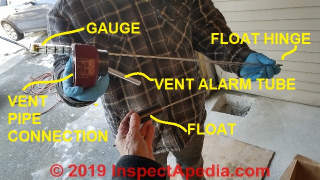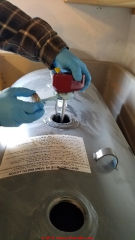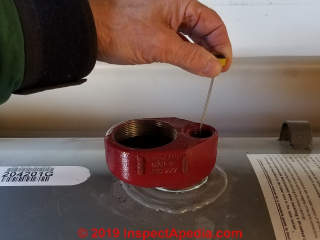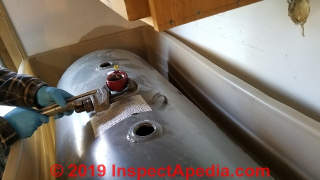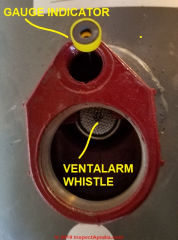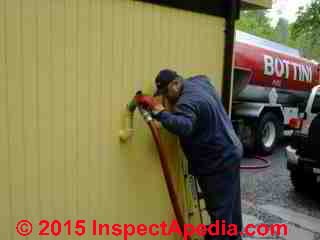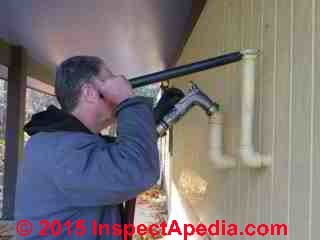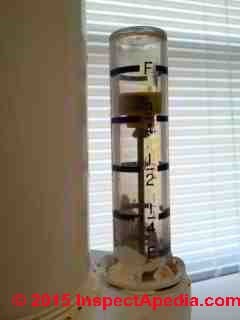 Oil Tank Gauge & Vent-Alarm Installation
Oil Tank Gauge & Vent-Alarm Installation
Find the level of heating oil & prevent oil tank over-fill & oil spills
- POST a QUESTION or COMMENT about how to select & install an oil tank level gauge & vent alarm
This article describes how to install an oil tank gauge & how to install the vent-alarm that prevents over-filling of the oil tank.
InspectAPedia tolerates no conflicts of interest. We have no relationship with advertisers, products, or services discussed at this website.
- Daniel Friedman, Publisher/Editor/Author - See WHO ARE WE?
Oil Tank Gauge & Vent Alarm Installation or Replacement
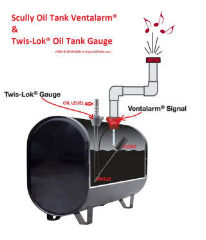
On both residential and commercial oil storage tanks both an oil tank level gauge (shown at page top) and a vent-alarm that tells the oil delivery driver when the tank is full are both essential instruments.
The Scully ventalarm, shown here, is mounted on the oil storage tank, at the connection of the oil tank vent piping.
As the oil tank is being filled, oil entering the storage tank pushes air out of the tank and outside through the vent piping shown in the illustration.
When the oil level in the storage tank nears the top of the tank, oil covers the opening at the bottom of the vent-alarm drop-tube, causing the whistling noise to stop when oil is a few inches from the very top of the oil tank.
The oil delivery driver hears this change in sound and knows to stop pumpigng oil at that point.
In Scully's Ventalarm illustration shown below, the oil level gauge and ventalarm are installed at two different tappings on the oil tank.
In other oil tank gauge and vent-alarm designs like that shown in our next photo, below, the oil tank float gauge and the vent alarm are built into the same fitting, again installed at the oil tank vent piping connection.
How to Install the Oil Tank Gauge & Vent-Alarm
Above: the Scully Ventalarm™ and Oil Tank Gauge (Scully Signal Co.) ready for installation. The old guy's hand (mine) in the lower portion of the photo is holding the gauge float. Notice that the float and gauge rods are hinged.
That silver tube hanging down from the red cast-iron Scully gauge assembly is the actual oil tank whistle or alarm that will go quiet when, as oil reaches the bottom of the tube, air stops exiting the tank through the whistle body.
With the oil tank upright and in position, and if necessary, with larger hole(s) drilled through the building wall to pass the full 2" diameter fill and vent pipes to the building exterior, the installers are ready to fit the Scully™ combination oil tank gauge and Vent Alarm into the oil tank top vent tapping.
Oil Tank Gauge & VentAlarm Installation Tip
As you prepare to insert the oil tank gauge assembly into the oil tank top tapping, pull up the oil tank gauge indicator to the "full" position and hold it or use a small ViseGrip™ pliers to hold the gauge in that position.
That will cause the gauge rod arms to bend to the most-closed position - similar to the photo of the gauge we showed just above.
With the oil tank gauge rods folded to the "closed" position you avoid bending, damaging, or fouling the gauge as it is inserted into and screwed down onto the oil tank top tapping.
The risk of a fouled oil tank gauge arm is even greater after the oil tank top oil piping assembly has been installed down into the tank, but it can happen any time.
My photo below shows how to pull the oil tank gauge indicator to the up-most or "full" position, though for convenience of photography I'm closing this barn door after the horse has escaped, as the gauge is now already installed into the oil tank tapping.
You would use this same trick if you needed to remove or replace the gauge in the future.
For pipe thread sealant the installers are using a product specifically rated for use on fuel oil piping connections.
Watch out: Using the wrong type of pipe dope can result in leaks that will be a nasty pain in the neck to fix later.
With the gauge hand-threaded (NOT cross-threaded) into the oil tank vent line tapping the Scully gauge and alarm assembly is tightened into place.
Below: a view into the Scully VentAlarm® and oil gauge assembly shows the actual whistling device in the vent system - that screened disc with a hole in the middle.
The screen over the Ventalarm® or "tank whistle" serves to keep bugs and crud from falling down the oil tank vent and into the alarm where they might cause it to malfunction.
Details about complete installation procedures for a heating oil storage tank are
at OIL TANK REPLACEMENT PROCEDURE
Oil Tank Gauge & Vent-Alarm Installation Instruction Manuals
Oil Tank Gauge & Vent-Alarm Installation Instruction Manuals
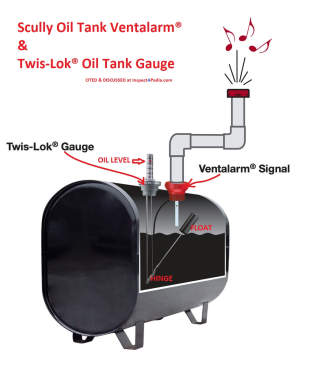 Illustration below, adapted from Scully's Tank & Unifill® Catalog cited just below, shows the typical position of and operation of a float type oil tank level gauge.
Illustration below, adapted from Scully's Tank & Unifill® Catalog cited just below, shows the typical position of and operation of a float type oil tank level gauge.
Shown here: Illustration of the Scully Twis-Lok® oil tank gauge and the company's Ventalarm® is adapated from Scully's catalog cited below.
Scully manufactures a variety of oil tank gauges or oil level indicators as well as oil tank fill signals and alarms - cited below.
Some sources point out that you'd be smart to install the oil tank gauge/vent alarm at the opposite end of the tank from the oil supply lines so as to avoid possible entanglement of the oil gauge float mechanism with the oil piping.
This pertains in particular to oil tanks whose oil supply (and return if used) piping is connected to the top of the oil tank. (Gil-Fab Tanks International 2016)
- Canada, Nova Scotia, INSTALLATION AND ENVIRONMENTAL MANAGEMENT GUIDE FOR
ABOVEGROUND DOMESTIC OIL TANKS
IN NOVA SCOTIA [PDF] (2007) Government of Nova Scotia, Tel: 1-800-670-4357, Web: https://beta.novascotia.ca/contact-us - retrieved 2022/08/19, original source: https://novascotia.ca/nse/petroleum/docs/OilTankInstall.pdf
Excerpt: All tank(s) shall be connected to a vent alarm or whistle which is an effective means of preventing overfilling. The vent alarm or whistles should be sized to allow for an adequate fuel expansion safety volume as determined by the tank manufacturer. - Gil-Fab, DWOT Fuel Oil Storage Tanks LICENSED INSTALLER INSTRUCTIONS [PDF] for Single Tank Installations, for aboveground nonmetallic tank for fuel oil & other combustible liquids, GIL-FAB Tanks International 1429 De la Gare Mascouche, QC, Canada J7K 3G6 Website: www.ats-tanks.com/UL2258 retrieved 2019/10/25 original source: https://images.homedepot-static.com/catalog/pdfImages/fd/fdd89385-9677-470a-9c17-ddc408ec6060.pdf
- Roth Fuel Level Gauges described in ECODWT PLUS 3 OIL STORAGE TANK [INSTALLATION INSTRUCTIONS [PDF] Roth Industries
268 Bellew Ave South
Watertown, NY 13601 USA Website: http://www.roth-usa.com retrieved 2019/10/25 original source: http://www.roth-usa.com/PDF_Download_Files/DWT_install_instructions.pdf
Excerpt:
Roth has an optional fuel level gauge that can be installed in the EcoDWT plus 3. These are sealed gauges and have 2” threaded connections with “O” ring seals and cord style floats.
- Scully, SCULLY TANK & UNIFILL® Catalog [PDF] (2017) World Headquarters
Scully Signal Company
70 Industrial Way
Wilmington, MA 01887
USA
Phone: 617-692-8601
or 1-800-272-8559 Fax: 617-692-8620
Sales@scully.com
Applications@scully.com - this catalog illustrates several types of oil tank fill / vent alarms and oil tank gauges.
Scully UK Meridian House Unit 33 37 Road One Winsford Industrial Estate Winsford, Cheshire CW7 3QG Phone: +44 (0)1606 553805 Fax: +44 (0)1606 553824 Sales@scullyuk.com
Scully Europe Maanstraat 25 2800 Mechelen Belgium Phone: +32(0)15560070 Fax: +32(0)15550070 Sales@scully.be
retrieved 2019/10/25 original source: http://www.scully.com/wp-content/uploads/2015/04/Scully-Oil-Delivery-Catalog_TankUNIFIL_2017.pdf?d2ec2a&d2ec2a - Scully, Ventalarm® Combination Whistle Alarm & OIL TANK LEVEL INDICATOR Data Sheet [PDF] (2015), op. cit.
Note that the Ventalarm is sold in 1 1/2" and 2" diameter fittings to correspond to those oil tank opening sizes, and the oil tank gauge mechanism is sold in different models corresponding to different oil tank depths. - Scully, SCULLY WHISTLER TANK ALARM INSTALLATION INSTRUCTIONS [PDF] Scully, Op. Cit.
...
Reader Comments, Questions & Answers About The Article Above
Below you will find questions and answers previously posted on this page at its page bottom reader comment box.
Reader Q&A - also see RECOMMENDED ARTICLES & FAQs
Question: how do I un-screw & remove an oil tank float gauge like the King Combo Oil Tank Gauge/Alarm ?
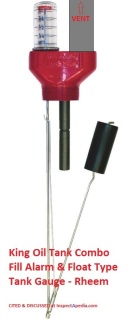 I need to remove the oil tank guage and replace it.
I need to remove the oil tank guage and replace it.
Would I just place the pipe wrench on the cast housing of the gauge and turn left? It has the fill pipe that enters the top of the housing and the bottom of the housing screws into the tank.
So, I believe by doing above would unscrew it from tank and pipe screwed into the top of it. - Clifford Hendershot by private email 2019/10/25
Reply: almost: pin the gauge in the "full" position before unscrewing it
If your King float type oil tank gauge looks like the one in the photo shown here, the King Combo Oil Tank Gauge (a widely-sold product produced by Rheem, then yes the red cast-iron body of the gauge is threaded directly into the threaded opening in the top of an oil tank.
If your oil tank gauge is like the one shown here a vent pipe is attached to the threaded opening in the red gauge body top. In a typical installation you will need to remove the vent pipe before attempting to unscrew the gauge from the tank body.
"Off" is standard pipe thread direction: turn the pipe or fitting counterclockwise to loosen it or turn it clockwise to tighten. As my daughter Mara says: leftie-loosie, rightie-tightie.
Below are a few "watch out" warnings and tips for installing or replacing an oil tank gauge and tank alarm.
Watch out: before buying and installing a combination oil tank whistle alarm and gauge be sure that your local plumbing inspector will accept that device (most do). Some inspectors may want separate devices: gauge and alarm; the companies listed below (and others) sell both types of devices.
Watch out: when using a pipe wrench on larger-sized plumbing fittings such as 1 1/2" or 2" diameter threaded fittings you may need to extend the length of your pipe wrench handle by slipping a length of iron pipe over the pipe wrench handle. Take care that you are turning the fitting and not the oil tank itself or you'll be really sorry.
Watch out: But before screwing an oil tank level gauge like this one - or any float type gauge that uses a hinged wire rod - you need to retract the gauge to the "full" position by removing the plastic cover over the gauge indicator and pulling the indicator fully "up" then holding it in that position (people typically use a small Vise Grip pliers for that task).
Otherwise as you turn the gauge body with your pipe wrench or a large open end or perhaps adjustable wrench you risk bending the float rod and jamming the whole assembly in the oil tank, or breaking off parts and dropping them into the tank.
To screw in the replacement oil tank gauge fitting you'll need a suitable pipe thread selant that is rated for use on oil or petroleum product piping (or perhaps teflon tape).
Watch out: also in some jurisdictions oil tanks and oil piping must be installed by a licensed professional. Making a mistake that causes a fire or oil leak can be both dangerous and expensive.
Photos: the Bottini heating oil delivery driver is filling an oil storage tank at a Poughkeepsie New York home. The oil tank lacks a working vent-alarm so the driver takes great care to listen at the tank vent outlet to determine when the tank is full. In our second photo (below) the heating oil delivery-driver uses a short length of plastic pipe as a sound conductor.
A better approach is to have a working tank whistle.
Watch out: without a proper oil tank vent alarm an oil tank can be over-filled, leading to oil leaks and spills and in the worst-case, a costly environmental cleanup job.
...
Continue reading at OIL TANK GAUGE SMART WIFI INSTALLATION, or select a topic from the closely-related articles below, or see the complete ARTICLE INDEX.
Recommended Articles
- HEATING OIL USAGE RATE - compare oil tank gauge readings with oil consumption rates.
- OIL TANK FILL & VENT PIPING INSPECTION CHECKLIST
- OIL STORAGE TANKS - home
- OIL TANK FILL & VENT PIPING INSPECTION CHECKLIST
- OIL TANK GAUGES - home
- OIL TANK LEAKS & SMELLS - home
- OIL TANK REPLACEMENT PROCEDURE - how to install or replace an oil storage tank, including fill & vent piping.
Suggested citation for this web page
OIL TANK GAUGE & VENT ALARM INSTALL / REPLACE at InspectApedia.com - online encyclopedia of building & environmental inspection, testing, diagnosis, repair, & problem prevention advice.
Or see this
INDEX to RELATED ARTICLES: ARTICLE INDEX to HEATING OIL, OIL BURNERS, OIL FIRED HEATERS, OIL TANKS
Or use the SEARCH BOX found below to Ask a Question or Search InspectApedia
Ask a Question or Search InspectApedia
Try the search box just below, or if you prefer, post a question or comment in the Comments box below and we will respond promptly.
Search the InspectApedia website
Note: appearance of your Comment below may be delayed: if your comment contains an image, photograph, web link, or text that looks to the software as if it might be a web link, your posting will appear after it has been approved by a moderator. Apologies for the delay.
Only one image can be added per comment but you can post as many comments, and therefore images, as you like.
You will not receive a notification when a response to your question has been posted.
Please bookmark this page to make it easy for you to check back for our response.
IF above you see "Comment Form is loading comments..." then COMMENT BOX - countable.ca / bawkbox.com IS NOT WORKING.
In any case you are welcome to send an email directly to us at InspectApedia.com at editor@inspectApedia.com
We'll reply to you directly. Please help us help you by noting, in your email, the URL of the InspectApedia page where you wanted to comment.
Citations & References
In addition to any citations in the article above, a full list is available on request.
- In addition to citations & references found in this article, see the research citations given at the end of the related articles found at our suggested
CONTINUE READING or RECOMMENDED ARTICLES.
- Carson, Dunlop & Associates Ltd., 120 Carlton Street Suite 407, Toronto ON M5A 4K2. Tel: (416) 964-9415 1-800-268-7070 Email: info@carsondunlop.com. Alan Carson is a past president of ASHI, the American Society of Home Inspectors.
Thanks to Alan Carson and Bob Dunlop, for permission for InspectAPedia to use text excerpts from The HOME REFERENCE BOOK - the Encyclopedia of Homes and to use illustrations from The ILLUSTRATED HOME .
Carson Dunlop Associates provides extensive home inspection education and report writing material. In gratitude we provide links to tsome Carson Dunlop Associates products and services.


